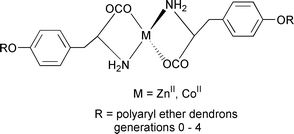Dendritic encapsulation of amino acid–metal complexes. Synthesis and studies of dendron-functionalized l-tyrosine–metal (ZnII, CoII) complexes
Abstract
This paper describes the synthesis, characterization and studies of dendrimers possessing an amino acid–metal complex as the core. Using Fréchet-type polyaryl ether dendrons, L-tyrosine–metal (ZnII and CoII) complex cored dendrimers of 0–4 generations were synthesized. The metal complexation of the tyrosine unit at the focal point of these dendrons took place smoothly, in excellent yields, even though the sizes of the dendrons increase as the generations advance. Spectrophotometric titrations with CoII metal ion confirmed the formation of a 2 ∶ 1 dendritic ligand to metal complex and the existence of a pseudotetrahedral geometry at the metal centre is also inferred. Cyclic voltammetric studies of dendrimer–CoII complexes showed that while the electron transfer of CoII to CoI was facile for generations 0–2, such a process was difficult with generations 3 and 4, indicating a rigid encapsulation of the metal ion centre by proximal dendron groups. Further reduction of CoI to Co0 and the corresponding oxidation processes appear to be limited by adsorption at the surfaces of the electrodes.


 Please wait while we load your content...
Please wait while we load your content...